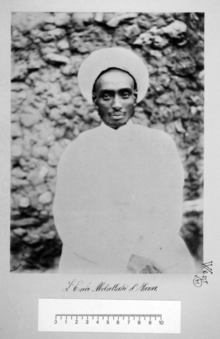
Back Harar Afrikaans ሐረር Amharic هرر (مدينة) Arabic هرر ARZ Harar Jugol AST Harar AVK Harar Azerbaijani هرر AZB Харэр Byelorussian Харар Bulgarian
Harar
ሐረር | |
|---|---|
Capital and walled city | |
From top, left to right: Badro Gate; Sherif Museum; Jamia Mosque; Chesa Selassie Church; city distant view | |
| Nickname: City of Saints (مدينة الأَوْلِيَا) | |
| Coordinates: 9°18′40″N 42°7′40″E / 9.31111°N 42.12778°E | |
| Country | Ethiopia |
| Region | |
| Government | |
| • President | Ordin Bedri |
| Elevation | 1,885 m (6,184 ft) |
| Population (2007)[1] | |
| • Total | 99,368 |
| • Estimate (2021)[2] | 153,000 |
| Time zone | UTC+3 (EAT) |
| Official name | Harar Jugol, the Fortified Historic Town |
| Criteria | Cultural: ii, iii, iv, v |
| Reference | 1189 |
| Inscription | 2006 (30th Session) |
| Area | 48 ha |

Harar[a] (Amharic: ሐረር; Harari: ሀረር;[4] Oromo: Adare Biyyo;[5] Somali: Herer; Arabic: هرر), known historically by the indigenous as Harar-Gey[6] or simply Gey[7] (Harari: ጌይ Gēy, lit. 'the city'), is a walled city in eastern Ethiopia. It is also known in Arabic as the City of Saints (Arabic: مدينة الأولياء, romanized: Madīna al-ʾAwliyāʾ).
Harar is the capital city of the Harari Region. The ancient city is located on a hilltop in the eastern part of the country and is about 500 kilometres (310 mi) from the Ethiopian capital Addis Ababa at an elevation of 1,885 metres (6,184 ft).
For centuries, Harar has been a major commercial center, linked by the trade routes with the rest of Ethiopia, the entire Horn of Africa, the Arabian Peninsula, Asia, and through its ports, the outside world. Harar Jugol, the old walled city, was listed as a World Heritage Site in 2006 by UNESCO in recognition of its cultural heritage.[8] Because of Harar's long history of involvement during times of trade in the Arabian Peninsula, the Government of Ethiopia has made it a criminal offence to demolish or interfere with any historical sites or fixtures in the city. These include stone homes, museums and items discarded from war. According to UNESCO, it is "considered 'the fourth holiest city' of Islam" with 82 mosques, three of which date from the 10th century, and 102 shrines.[9][10]
Yahyá Naṣrallāh's Fatḥ Madīnat Harar, an unpublished history of the city in the 13th century, records that the legendary saint Abadir Umar ar-Rida and several other religious leaders settled in the Harar plateau c. 1216 (612 AH).[11] Harar was later made the new capital of the Adal Sultanate in 1520 by the Sultan Abu Bakr ibn Muhammad.[12] The city saw a political decline during the ensuing Emirate of Harar, only regaining some significance in the Khedivate of Egypt period. During the Ethiopian Empire, the city decayed while maintaining a certain cultural prestige.
- ^ Cite error: The named reference
census2007was invoked but never defined (see the help page). - ^ "Population Projection Towns as of July 2021" (PDF). Ethiopian Statistics Agency. 2021. Retrieved 31 May 2022.
- ^ Chisholm, Hugh, ed. (1911). . Encyclopædia Britannica. Vol. 18 (11th ed.). Cambridge University Press. p. 16.
- ^ Leslau, Wolf (1959). "An Analysis of the Harari Vocabulary". Annales d'Ethiopie. 3: 275. doi:10.3406/ethio.1959.1310.
- ^ Cite error: The named reference
:0was invoked but never defined (see the help page). - ^ Mordechai, Abir. Trade and Politics in the Ethiopian Region 183O–1855 (PDF). University of London. p. 246.
- ^ Baynes-Rock, Marcus (24 August 2015). Among the Bone Eaters Encounters with Hyenas in Harar. Penn State University Press. ISBN 9780271074047.
- ^ "Panda sanctuary, tequila area join UN World Heritage sites". Un.org. 13 July 2006. Retrieved 23 July 2013.
- ^ "Harar Jugol, the Fortified Historic Town". World Heritage List. UNESCO World Heritage Centre. Retrieved 6 August 2009.
It is considered 'the fourth holy city' of Islam, having been founded by a holy missionary from the Arabic Peninsula.
- ^ "Five new heritage sites in Africa". BBC. 13 July 2006. Retrieved 18 December 2006.
Harar Jugol, seen as the fourth holiest city of Islam, includes 82 mosques, three of which date from the 10th Century, and 102 shrines.
- ^ Siegbert Uhlig, Encyclopaedia Aethiopica: He-N, Volume 3, (Otto Harrassowitz Verlag: 2007), pp.111 & 319.
- ^ Richard Pankhurst, History of Ethiopian Towns (Wiesbaden: Franz Steiner Verlag, 1982), p. 49.
Cite error: There are <ref group=lower-alpha> tags or {{efn}} templates on this page, but the references will not show without a {{reflist|group=lower-alpha}} template or {{notelist}} template (see the help page).
© MMXXIII Rich X Search. We shall prevail. All rights reserved. Rich X Search







